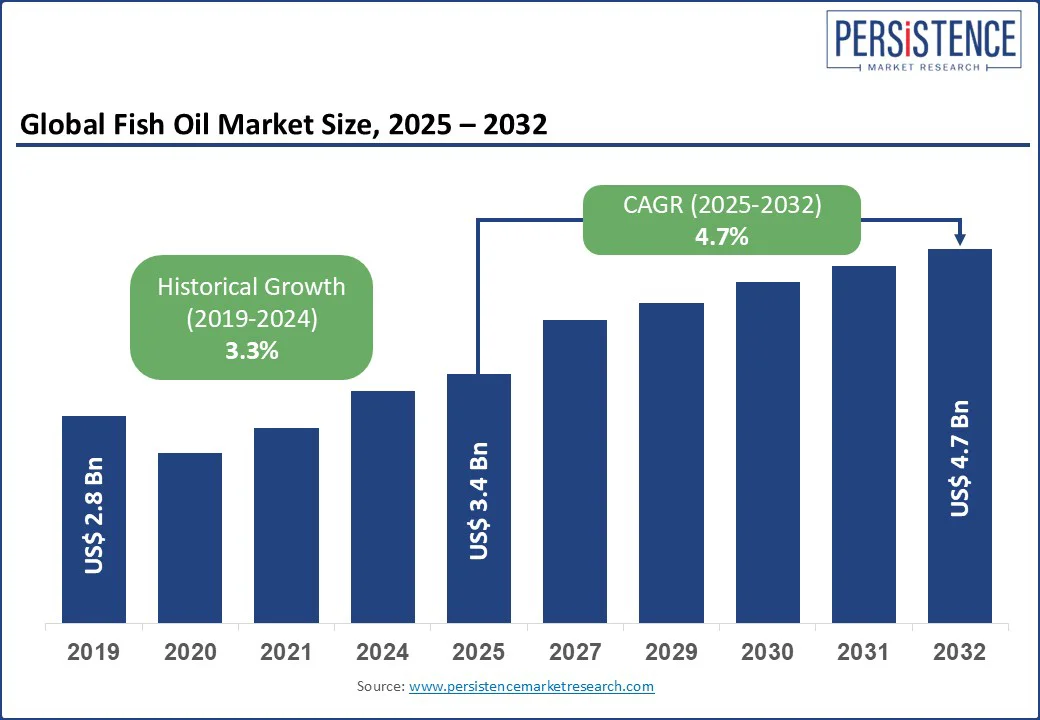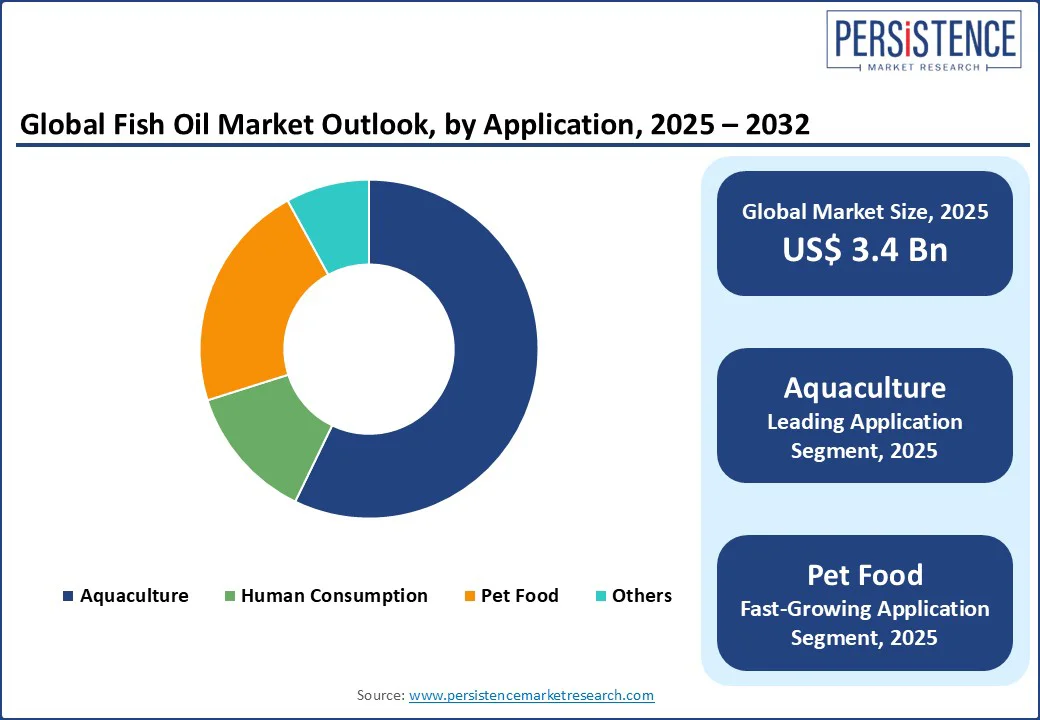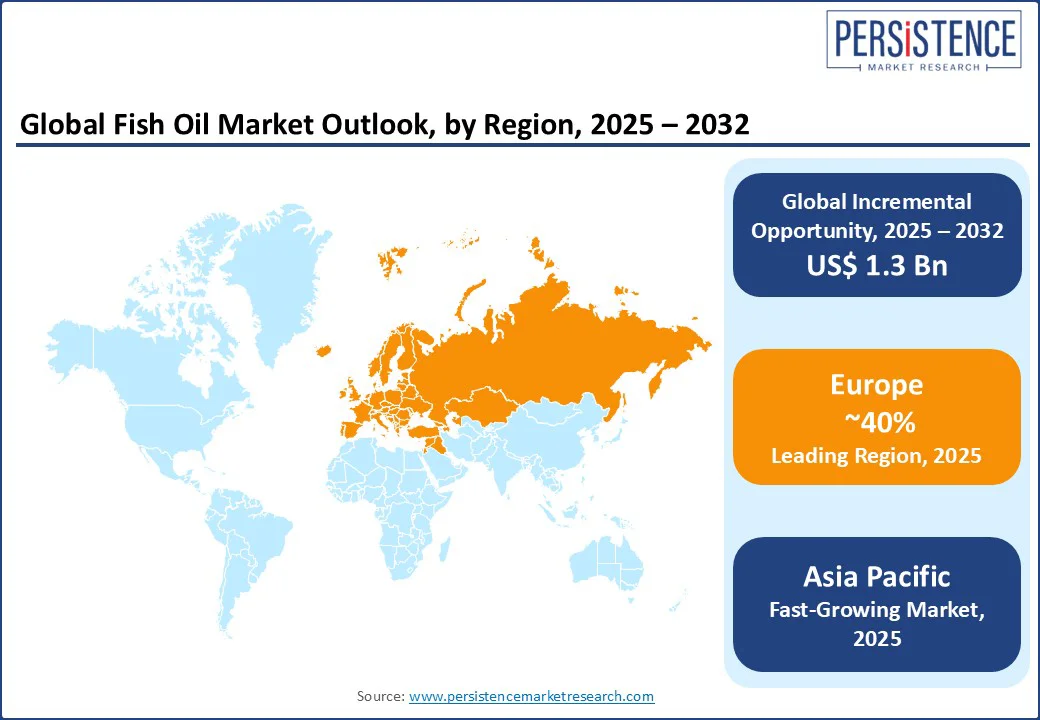ID: PMRREP30259| 204 Pages | 22 Aug 2025 | Format: PDF, Excel, PPT* | Food and Beverages

The global fish oil market size is likely to be valued at US$ 3.4 Bn in 2025 and is expected to reach US$ 4.7 Bn by 2032, registering a CAGR of 4.7% during the forecast period 2025 -2032.
The Fish Oil market has experienced steady growth, driven by increasing awareness of omega-3 fatty acids' health benefits, expansion in the aquaculture sector, and rising demand for nutritional supplements and pet food formulations.
Key Industry Highlights:

|
Global Market Attribute |
Key Insights |
|
Fish Oil Market Size (2025E) |
US$ 3.4 Bn |
|
Market Value Forecast (2032F) |
US$ 4.7 Bn |
|
Projected Growth (CAGR 2025 to 2032) |
4.7% |
|
Historical Market Growth (CAGR 2019 to 2024) |
3.3% |
The global surge in awareness of omega-3 fatty acids' benefits for cardiovascular and cognitive health is a primary driver of the Fish Oil market. According to the World Health Organization, cardiovascular diseases account for over 17.9 million deaths annually, with heart disease and stroke being the leading causes.
The rising prevalence of these conditions, particularly among aging populations, drives demand for fish oil supplements rich in eicosapentaenoic acid (EPA) and docosahexaenoic acid (DHA). In Europe, a significant share of older adults consume omega-3 supplements regularly, necessitating advanced extraction and purification technologies to meet demand.
Technological advancements in fish oil refining and encapsulation are propelling market growth. Modern systems, such as DSM’s high-concentrate omega-3 oils, offer improved bioavailability and reduced oxidation, enhancing consumer satisfaction. A recent clinical study found that omega-3 supplementation reduces the risk of sudden cardiac death compared to placebo, further boosting consumer confidence. The integration of sustainable sourcing practices and vegan omega-3 alternatives, such as algae-based oils, supports adoption in functional foods and beverages.
Government health initiatives and increased funding for nutritional programs also drive market expansion. In India, national nutrition schemes such as the Poshan Abhiyaan have expanded access to omega-3 fortified products, increasing demand for fish oil. In Europe, favorable regulatory policies, such as the European Food Safety Authority’s (EFSA) approval of omega-3 health claims, incentivize manufacturers to invest in high-quality extracts, further fueling market growth.
Sustainability concerns in fish oil sourcing continue to hinder widespread adoption, particularly in environmentally conscious markets such as Europe. Fish oil is often derived from overfished species such as anchovy and sardine, leading to concerns about marine ecosystem depletion and bycatch.
The high cost of sustainable sourcing, such as Marine Stewardship Council (MSC)-certified fisheries, adds to production expenses, with advanced purification systems commanding significant upfront investment. Additionally, ongoing costs for quality testing and compliance with environmental regulations, such as the EU’s Common Fisheries Policy, increase the total cost of ownership.
For manufacturers in resource-limited regions, such as parts of Latin America and Southeast Asia, these financial burdens limit scalability, restricting access to premium fish oil products.
The need for skilled personnel to operate advanced extraction and purification systems also poses a challenge. Producing high-quality fish oil requires expertise in molecular distillation and quality control, and a recent industry survey reported a shortage of trained technicians in Asia Pacific processing facilities. This skills gap, combined with high training costs, restricts the adoption of advanced technologies in developing regions, slowing market growth.
The development of sustainable and alternative fish oil sources presents significant growth opportunities, particularly by enabling environmentally friendly production for eco-conscious consumers. Algae-based omega-3 oils, such as those produced by DSM and BASF, offer a vegan-friendly alternative to traditional fish oil, reducing reliance on overfished species.
These innovations address sustainability concerns and appeal to the growing vegan and vegetarian demographics, particularly in Europe and North America. For instance, Corbion’s AlgaPrime DHA is gaining traction in aquaculture feed, exemplifying the shift toward sustainable solutions.
The rise of premium pet food formulations offers another growth avenue. Fish oil, rich in omega-3s, is increasingly used in pet food to enhance coat health and cognitive function in dogs and cats. A 2024 market study found that premium pet food sales grew by 8% globally, driving demand for high-quality fish oil in formulations. Companies such as Ocean Group Ltd. are capitalizing on this trend by offering tailored fish oil grades for pet food manufacturers.
The growing adoption of digital health platforms and blockchain for supply chain transparency also enhances market potential. Companies such as Croda International are integrating IoT-based traceability systems, ensuring sustainable sourcing and regulatory compliance. This trend supports market expansion by addressing consumer concerns about ethical production and improving supply chain efficiency.
The global fish oil market is segmented into Traditional Pelagic and Demersal Species, Tuna, Salmon, Pangasius, and Tilapia. Traditional Pelagic and Demersal Species dominate, holding approximately 65.30% of the Fish Oil market share in 2025, due to their abundant availability and high oil yield. Species such as anchovy, sardine, and mackerel are widely used for their rich omega-3 content, making them a cost-effective choice for large-scale extraction.
Salmon is the fastest-growing segment, driven by increasing demand for premium fish oil in dietary supplements and functional foods. Its high DHA content and consumer preference for premium-grade oils, particularly in Europe and North America, boost its adoption in high-value markets.
By application type, the Fish Oil market is divided into Human Consumption, Aquaculture, Pet Food, and Others. Aquaculture leads with a 57.4% share in 2025, driven by its high usage in feed formulations for farmed fish such as salmon and shrimp. Fish oil is critical for enhancing growth and disease resistance in aquaculture species, with over 70% of global fish oil production consumed by this sector.
Pet Food is the fastest-growing segment, fueled by rising pet ownership and demand for premium pet nutrition. The increasing use of fish oil in pet food to support joint health and coat quality, particularly in Europe and North America, drives demand for specialized formulations.

In North America, the U.S. is a significant market, driven by high consumer awareness of omega-3 benefits and a robust dietary supplement industry. In the U.S., demand for high-purity fish oil is rising, fueled by increasing consumption of omega-3 supplements and functional foods. Leading brands such as DSM and Omega Protein Corporation continue to offer innovative, high-concentrate solutions to meet consumer needs.
Consumer preferences are shifting toward sustainable and traceable fish oil products, with companies such as BASF incorporating MSC-certified sourcing to enhance credibility. Health consciousness remains a priority, and stringent FDA regulations encourage the adoption of high-quality, purified oils. Additionally, favorable policies for dietary supplement claims further incentivize manufacturers to invest in advanced refining technologies, supporting market growth.
Europe is the leading region in the global fish oil market, holding a 40% market share in 2025, led by Norway, Germany, and the U.K., driven by regulatory support and high consumption of omega-3 products. Norway holds the largest share within Europe, supported by strong sales from leading brands such as Pelagia AS and TripleNine. The EU’s strict regulations on sustainable fishing, such as the Common Fisheries Policy, foster innovation and compliance, encouraging the adoption of MSC-certified fish oil and algae-based alternatives across major markets.
In the U.K., market growth is driven by the rising preference for omega-3 fortified functional foods. Products such as Croda International’s Incromega are gaining popularity for their high purity and bioavailability. Meanwhile, Germany is witnessing increased demand for pet food applications, with companies such as BASF offering specialized fish oil grades. Regulatory support for sustainable production practices across Europe further enhances market prospects.
Asia Pacific remains the fastest-growing region for the Fish Oil market, with China, India, and Thailand emerging as key contributors. In India, heightened health awareness and supportive government nutrition programs, such as Poshan Abhiyaan, are fueling demand for affordable fish oil supplements, with companies such as Sürsan leading the supply of cost-effective, semi-refined oils.
China’s growth is underpinned by extensive aquaculture expansion, where brands such as OLVEA Group provide high-quality fish oil for feed applications. Thailand, on the other hand, is carving a niche in premium-grade fish oil for shrimp farming, with GC Rieber gaining prominence. Rising healthcare investments and digital procurement platforms further bolster regional market expansion.

The global fish oil market is highly competitive, with global and regional players competing on innovation, sustainability, and pricing. The rise of algae-based and MSC-certified fish oil intensifies competition, as companies aim to meet stringent environmental and quality standards. Strategic partnerships, regulatory certifications, and investments in refining technologies are key differentiators.
The Fish Oil market is projected to reach US$ 3.4 Bn in 2025.
Rising health awareness, aquaculture expansion, and government nutrition initiatives are the key market drivers.
The Fish Oil market is poised to witness a CAGR of 4.7% from 2025 to 2032.
Innovation in sustainable sourcing and pet food applications are the key market opportunities.
Ocean Group Ltd., Croda International plc, and DSM are among the key market players.
|
Report Attribute |
Details |
|
Historical Data/Actuals |
2019 - 2024 |
|
Forecast Period |
2025 - 2032 |
|
Market Analysis Units |
Value: US$ Bn Volume: As Applicable |
|
Geographical Coverage |
|
|
Segmental Coverage |
|
|
Competitive Analysis |
|
|
Report Highlights |
|
|
Customization and Pricing |
Available upon request |
By Species Type
By Application Type
By Region
Delivery Timelines
For more information on this report and its delivery timelines please get in touch with our sales team.
About Author